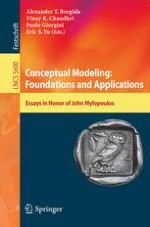This Festschrift volume, published in honor of John Mylopoulos on the occasion of his retirement from the University of Toronto, contains 25 high-quality papers, written by leading scientists in the field of conceptual modeling. The volume has been divided into six sections. The first section focuses on the foundations of conceptual modeling and contains material on ontologies and knowledge representation. The four sections on software and requirements engineering, information systems, information integration, and web and services, represent the chief current application domains of conceptual modeling. Finally, the section on implementations concentrates on projects that build tools to support conceptual modeling. With its in-depth coverage of diverse topics, this book could be a useful companion to a course on conceptual modeling.
